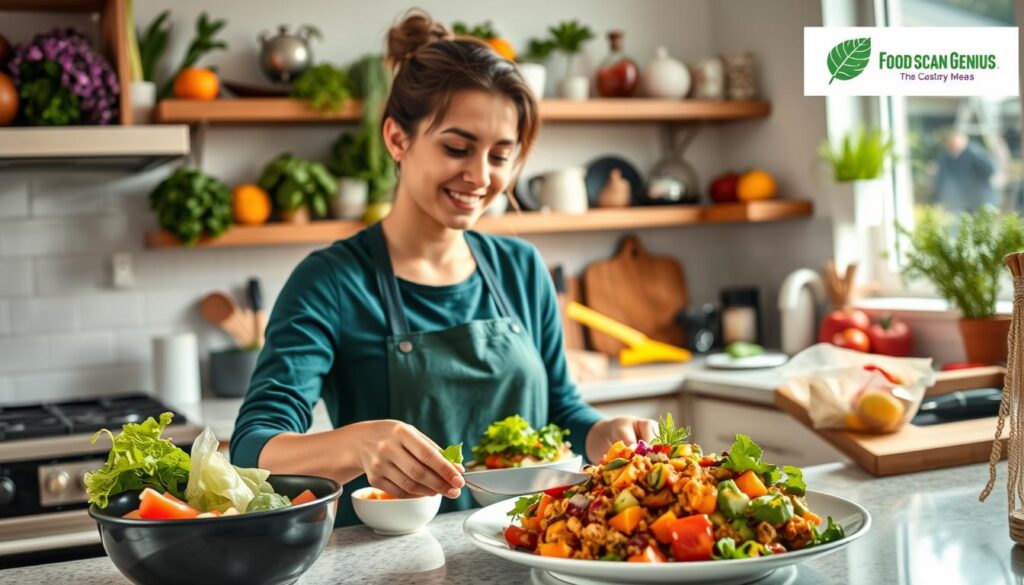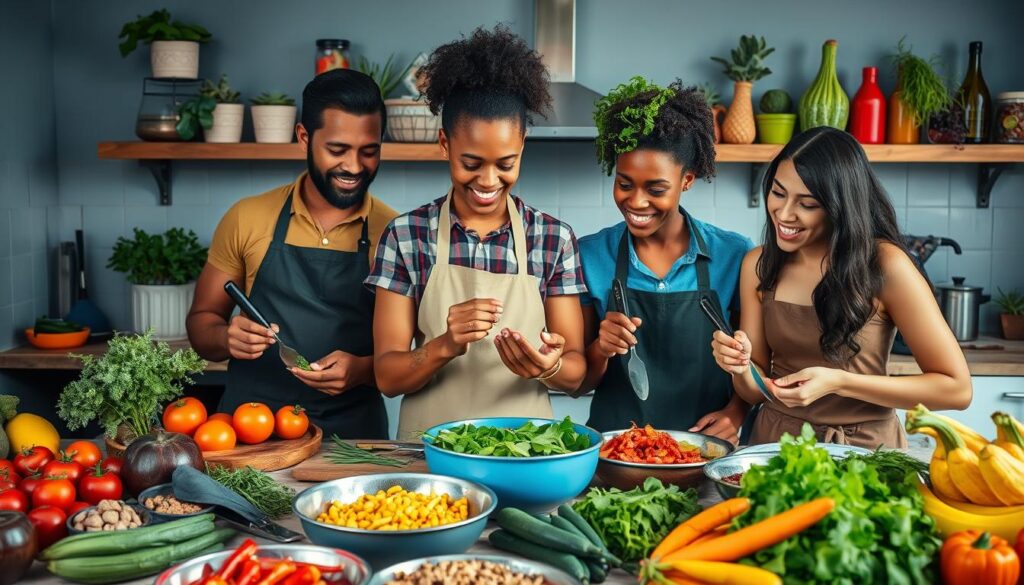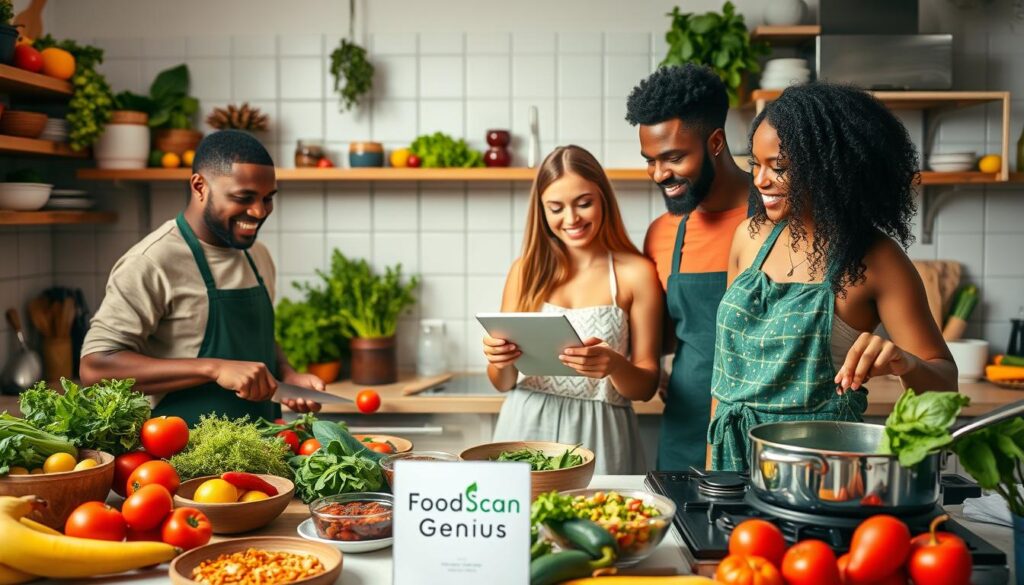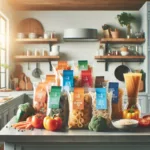Vegan cooking is a world of endless possibilities and amazing flavors. As a plant-based enthusiast, I’m excited to share my best tips for making delicious meals. These tips are perfect for both seasoned vegans and newcomers to the plant-based lifestyle.
Imagine yourself in your kitchen, surrounded by colorful veggies and tasty plant-based ingredients. You’re ready to start a culinary journey. The Food Scan Genius app makes shopping for vegan ingredients easy1. Let’s explore vegan cooking together, where simple changes and planning lead to satisfying meals.
Key Takeaways
- Discover the essentials for stocking your vegan pantry and fridge
- Learn how to balance your plant-based meals for optimal nutrition
- Explore a world of flavor-boosting herbs, spices, and cooking techniques
- Conquer the art of vegan meal prep and batch cooking
- Find inspiration in the vibrant vegan food community
Understanding Vegan Ingredients
Let’s explore the key ingredients for vegan cooking. We’ll look at protein sources and pantry staples. These are the building blocks of tasty vegan dishes.
Common Plant-Based Proteins
Vegan cooking has many meat substitutes. You can use tofu, seitan, lentils, jackfruit, chickpeas, nuts, and seeds2. These ingredients provide the protein needed for a plant-based diet and satisfy your taste buds.
Essential Pantry Staples
Keep your vegan kitchen stocked with healthy grains like farro, brown rice, wild rice, and millet. Nut butters, plant-based oils, and vegan milk substitutes are also key2. Don’t forget flaxmeal and water or applesauce for egg substitutes, and aquafaba for egg whites2.
Fresh Produce Selection
Leafy greens like kale, spinach, and mint are crucial in a vegan diet2. Nuts and seeds can be turned into butter, pesto, cheese, or milk2. Vinegars and spices add depth to your dishes2. Sweeteners like agave nectar and maple syrup replace honey in vegan recipes2.
Nutritional yeast gives a cheesy flavor and thickens dishes2. Learning various cooking techniques is also important2. Tools like spiralizers and slicers help in preparing ingredients.
With these vegan ingredients, you can make delicious plant-based meals. They will nourish your body and satisfy your taste buds.
Embrace the diversity of vegan ingredients and let your culinary creativity soar!
Flavoring Your Dishes
Maximizing flavors is key to great vegan cooking. Whether it’s a savory stir-fry or dairy-free cookies, the right mix of herbs, spices, and unique ingredients makes all the difference. Let’s explore how to bring incredible flavors to your vegan dishes!
Herbs and Spices to Try
Herbs and spices are the real stars of vegan cooking. They add depth and nutrition to your meals3. From oregano and dill in Greek dishes to Thai lemongrass and basil, there’s a world of taste to discover3.
Indian spices like cumin and cardamom, and Japanese miso and soy, offer unique flavors3. Mexican chili peppers add smokiness, and vegan seasoning blends can mimic meat and seafood3.
Creating Balanced Flavors
The secret to amazing vegan dishes is finding the right balance of flavors4. Pair fresh herbs with fats like olive oil or vegan butter to unlock their aroma4. Use salt to bring out the sweetness of veggies and mix spices that match your ingredients4.
Whether it’s a vibrant curry or a cozy casserole, mastering flavor layering will elevate your vegan cooking.
Nutritional Yeast: A Game-Changer
Nutritional yeast is a must-try for vegan cooking4. It adds a cheesy, nutty taste and is packed with nutrients4. Use it on roasted veggies, in sauces, or as a breading for crispy dishes. It’s a versatile way to boost your vegan dishes’ flavor.
Remember, the key to flavorful vegan cooking is to experiment. Explore the wide range of plant-based flavors and get creative with your seasonings. Your taste buds and even your non-vegan friends will love it34!
Mastering Cooking Techniques
Learning vegan cooking techniques is essential for tasty plant-based meals. We’ll show you how to make everything from sizzling sautés to steamed veggies. Say goodbye to boring meals and hello to vibrant flavors!
Sautéing vs. Steaming: The Vegan Cooking Showdown
Sautéing and steaming are crucial for every vegan cook. Sautéing veggies in a hot pan with oil or butter makes them sweet and caramelized. Steaming keeps veggies crisp and colorful, saving nutrients. Knowing both methods lets you make many tasty vegan dishes.
Roasting for Enhanced Flavors
It turns simple ingredients into flavor bombs. High heat caramelizes sugars, adding depth of flavor that other methods can’t match5. It also makes textures like crispy potatoes and caramelized Brussels sprouts perfect.
Tips for Perfectly Cooked Grains
Fluffy, evenly cooked grains are key for many vegan meals. Whether it’s quinoa, brown rice, or farro, a few tips can help. Focus on the right grain-to-liquid ratio, simmer at the correct temperature, and let grains rest after cooking. This ensures they’re light and flavorful for your dishes.
With these techniques, you’ll make amazing, restaurant-quality meals at home. Impress your friends and family with your new cooking skills!
Meal Prep and Planning
Got a busy schedule and love plant-based food? No worries! Mastering meal prep is key to enjoying tasty vegan meals easily. We’ll explore the perks of batch cooking, freezing meals, and making sure they’re healthy.
Batch Cooking Benefits
Meal prep can take 3-4 hours, covering prep, cooking, and storage6. With just 2 recipes making 4 servings each, you’re set for up to 5 days6. It saves time and can cut down grocery costs by avoiding impulse buys6.
Whether you prep on a weekend or Monday, it reduces decision fatigue. You’ll have healthy options ready whenever you need them6.
Easy Vegan Freezer Meals
Freezing vegan meals is a big plus. You can have stews, curries, and casseroles ready for busy nights. With some planning, you can enjoy homemade vegan meals without daily stress.
And the best part? Freezer meals often taste better after a few days. This lets you enjoy deeper flavors.
Balancing Nutrients in Your Meals
Variety is key in a plant-based diet. Meal prep lets you mix fruits, veggies, grains, and proteins thoughtfully6. This ensures you get all the nutrients your body needs6.
By choosing meals with different colored produce, you nourish your body with many phytonutrients6. The Food Scan Genius app helps you check ingredients and balance your meals.
So, let’s make healthy eating easy. Embrace meal prep, freeze meals, and nourish your body with a delicious vegan diet. Your future self will be grateful!
Exploring Vegan Substitutes
Vegan cooking has made huge strides, offering a wide range of tasty plant-based options. You can find everything from creamy dairy alternatives to egg replacers and meat-free choices. The world of vegan ingredient swaps is vast and exciting7.
Dairy Alternatives Worth Trying
The dairy aisle now includes many vegan options. Brands have created vegan cheeses, milks, yogurts, and butters that are just as good as the real thing. Try shredded, sliced, and block cheeses, along with creamy cheese sauces and ricotta-style spreads7. For dessert lovers, there’s vegan whipped cream and ice cream too7.
Replacing Eggs in Baking
It’s easy to bake without eggs. There are many reliable substitutes for making cakes, cookies, and more light and fluffy. Try commercial egg replacers like Bob’s Red Mill, or get creative with “flax egg” or aquafaba (chickpea liquid). These alternatives can make your desserts amazing7.
Choosing Meat Alternatives
The vegan meat market has grown a lot, offering many options for burgers, sausages, bacon, and deli slices. You can choose from plant-based patties, crumbles, or whole-food substitutes like jackfruit. Swapping meat for plants just once a week can boost heart health and cut down on greenhouse gases8. Starting with one or two meat-free meals a week can lead to a full plant-based diet8.
With so many vegan ingredient substitutions, you can recreate your favorite dishes in new ways. Dive into the world of plant-based cooking and discover a universe of tasty, dairy-free, and meat-free options7.
| Vegan Ingredient Substitutions | Description |
|---|---|
| Dairy Alternatives | Vegan cheese, milk, yogurt, butter, and ice cream |
| Egg Replacers | Commercial egg replacers, flax eggs, aquafaba |
| Meat Alternatives | Burgers, sausages, bacon, deli slices, and whole-food options like jackfruit |
“Swapping out meat just once a week not only improves heart health but also reduces the production of greenhouse gases.”8
Quick and Easy Vegan Recipes
Are you tired of spending hours in the kitchen? Don’t worry, we’ve got you covered. Our quick and easy vegan recipes will make you say, “Wow, I made this?” in no time. Whether you’re looking for a 30-minute meal or a one-pot wonder, we’ve got delicious options for you.
30-Minute Meal Ideas
Want to try Crispy Tofu? It’s quick, with just 2 minutes of prep and 15 minutes of cooking9. It’s also low in calories, with 436 calories, 21g of carbs, 17g of protein, and 34g of fat9. This Crispy Tofu recipe is a game-changer for a quick and easy meal9!
One-Pot Vegan Recipes
One-pot meals are all about simplicity. Say goodbye to endless dishes and hello to convenience. We have a variety of one-pot recipes, from Tex-Mex to stews, that are quick and easy10. Many of these recipes use just 5 main ingredients, perfect for busy weeknights11.
Starting with Simple Salads
Salads are powerful and can be a quick, satisfying meal. Start with leafy greens, add your favorite veggies, proteins, and toppings, and you’re done in minutes11. For a fast and healthy breakfast, try a smoothie or avocado toast – both are delicious and filling11.

Whether you’re short on time or just want something simple and tasty, these vegan recipes are perfect. Impress your taste buds and your family with these mouthwatering plant-based dishes91110!
Elevating Your Vegan Baking Skills
Calling all sweet-toothed vegans! Baking delicious plant-based treats is easier than you think. With a few key vegan baking techniques, you can make cakes, cookies, and more that everyone will love12.
Essential Vegan Baking Techniques
Learning vegan baking starts with knowing how to swap out eggs and dairy. Flaxseed meal, applesauce, and silken tofu are great egg substitutes13. Plant-based milks like almond, oat, and coconut milk can replace dairy13. Try using coconut or avocado oil, or unsweetened applesauce for moist, tasty results13.
Tips for Vegan Cakes and Cookies
For vegan cakes and cookies, it’s all about finding the right mix of flavors and textures. Add umami-rich ingredients like nutritional yeast, miso, or soy sauce for depth13. Use lemon juice or vinegar to add brightness13. Learning to sauté, steam, and roast can also improve your vegan baking13.
Substituting Ingredients in Baking
Vegan baking offers endless chances to try new ingredients. Use plant-based sweeteners like maple syrup, agave nectar, or coconut sugar for sweetness without refined sugar13. Try vegan recipes from around the world, like Indian chana masala, Thai green curry, or Mediterranean falafel13. With a good pantry and creativity, the vegan baking world is yours to explore.
Whether you’re an experienced vegan baker or just starting, remember to have fun and be patient. With these tips, you’ll make desserts that wow even the toughest critics12. Get ready to enjoy delicious, guilt-free treats!
Staying Inspired in the Kitchen
Vegan cooking is a fun journey with endless possibilities. We have amazing resources to keep your creativity going. Explore vegan food blogs and get inspired14! These bloggers share thousands of vegan recipes, adding to the online cooking resources14.
Trying international cuisines is another great way to grow your vegan cooking skills. You can find dishes like tofu-based Asian foods and bean-rich Indian recipes14. And the best part? You don’t need a passport to start this culinary journey!
Following Vegan Food Blogs
- Find delicious vegan recipes and be inspired by others’ creativity.
- Keep up with the latest vegan cooking trends and techniques by following your favorite bloggers.
- Join a community of like-minded people and get tips and support for your vegan lifestyle.
Experimenting with International Cuisines
Try new flavors by exploring international vegan cuisines14. Asian and Indian dishes are full of plant-based recipes using tofu, beans, peas, and lentils14. Expand your cooking skills and delight your taste buds with these global flavors.
Joining Vegan Cooking Communities
Connecting with others in vegan cooking communities can change your game15. You can find free Tofu Masterclass replays and Healthy Vegan Batch Cooking Club Challenges. These communities offer support, inspiration, and practical tips15. Join in, share your dishes, and learn from others on a similar journey.
Remember, the Food Scan Genius app is your guide, helping you understand ingredient lists and make smart choices14. So, let’s make every meal an exciting adventure of new flavors and techniques. Happy cooking, fellow vegan enthusiasts!

Making Vegan Cooking Sustainable
Exploring vegan cooking opens up a world of flavors. It also lets us think about how our food choices affect the planet. By choosing sustainable ways to cook, we can make meals that are good for us and the Earth16.
Choosing Organic and Local Produce
Try to pick organic fruits and veggies grown close to you. These choices help local farmers and cut down on carbon emissions from long trips. Organic foods also avoid harmful pesticides, making them better for you and the planet.
Reducing Food Waste Tips
Food waste is a big problem, with 1.4 billion tons of food thrown away each year worldwide16. To fight this, get creative with leftovers and use all parts of your produce. Plan your meals to avoid waste. Tools like Food Scan Genius can help track your food use and cut down on waste.
Seasonal Ingredients for Better Meals
Using seasonal produce boosts local farming and makes your vegan meals taste better. Foods in season are cheaper, fresher, and more flavorful. Try new seasonal ingredients to find tasty dishes and support a greener food system.
FAQ
What are some common plant-based protein sources I can use in vegan cooking?
What are the essential vegan pantry staples I should have on hand?
How can I select the freshest fruits and vegetables for my vegan recipes?
What are some unique herbs and spices that can enhance the flavors in vegan cooking?
How can I make sure I’m getting all the necessary nutrients in my vegan diet?
What are some dairy-free alternatives I can use in vegan baking and cooking?
What are some quick and easy vegan meal ideas for busy weeknights?
How can I elevate my vegan baking skills and create delicious treats?
Where can I find inspiration and support for my vegan cooking journey?
How can I make my vegan cooking more sustainable and eco-friendly?
Source Links
- 10 Essential Plant-Based Cooking Tips – Sharon Palmer, The Plant Powered Dietitian
- Veganism 101: The Basics of Vegan Cooking
- 3 Huge Tricks To Make Vegan Food That Tastes Amazing!
- Vegan 101: How To Use Seasoning For Delicious Vegan Meals
- Mastering the Art of Plant-Based Cooking: Vegan Recipes, Tips, and Techniques [A Cookbook]
- A Beginner’s Guide to Vegan Meal Prep
- The Ultimate Guide to Vegan Substitutes — Vegan Cooking with Love
- Exploring Vegan | Easy vegan recipes and plant-based product reviews.
- 20 Minute Vegan Meals
- 85 Best Vegan Recipes – Love and Lemons
- Easy Vegan Meals
- Vegan Cooking Guide: Learn the Basics in Under an Hour
- Top Vegan Cooking Tips to Elevate Your Culinary Game
- Vegan cooking for beginners: get started the easy way (even if you think you’ll never go vegan) – Vegan Family Kitchen
- Strategies for vegan cooking, meal planning, batch cooking, and kitchen organization – Vegan Family Kitchen – Vegan Family Kitchen
- Vegan Food and Recipes — Sustainable Rookie






4 Comments
[…] Vegan “Chicken” Caesar Wraps with marinated tofu or seitan […]
[…] In the ever-evolving world of plant-based cuisine, few names shine as brightly as Sarah Kramer. As an acclaimed vegan cookbook author, Kramer has played a pivotal role in transforming veganism from a niche lifestyle into a joyful, mainstream movement. Her inventive approach, infectious enthusiasm, and accessible recipes have inspired countless individuals—especially those with food sensitivities and dietary preferences—to embrace veganism with open arms. […]
[…] you know many vegan recipes require only 8 ingredients or less? This makes them surprisingly accessible for beginners. Contrary to popular belief, vegan […]
[…] Vegans and vegetarians: Plant-based ingredients and dairy substitutes. […]